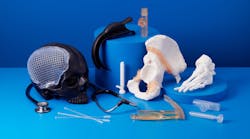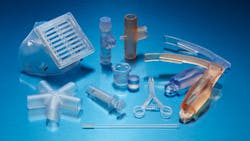Q&A: Going with the Additive Workflow: Formlabs Expands Healthcare Business
READ MORE: Thanks for Sharing: Reusable Open Source Hardware Respirators
Rising support and funding for 3D printing in medical and dental applications, along with the adoption of digital workflows and manufacturing, are clear signals that additive manufacturing companies are latching onto opportunities in the healthcare space.
It’s a trend that 3D printing company Formlabs is betting on and has made clear by revealing its strategy to double down on the healthcare sector. The appointment of Guillaume Bailliard as president of its healthcare division in September 2022 solidifies that intention.
“I foresee incredible opportunity for 3D printing to transform healthcare and dentistry, particularly in clinical end-use cases,” said Bailliard, who is no newcomer to 3D printing solutions for medical device markets and brings with him 25 years of experience.
3D printing has been at the center of Baillard’s career from the get-go. He started out as a design engineer and can recall using the technology to prototype medical devices. Stints at GE Healthcare and several early-stage healthcare companies followed. His career choices ultimately landed him a role at the forefront of additive manufacturing.
“Formlabs stood out to me as an innovative company with a strong focus on continuous R&D, which is paramount to long-term success in the healthcare market,” he said.
Machine Design: Given the size and growth of the healthcare and medical devices market, what is driving demand for 3D printing in this space?
Guillaume Bailliard: There is massive opportunity for 3D printing in healthcare, but the market is still at its infancy on the adoption curve. Demand for personalized healthcare is an important driving force in 3D printing in this space, as 3D printed medical devices, implants, surgical guides, and more can add efficiency while improving patient outcomes.
MD: Give us a high-level SWOT analysis of 3D printing: What are the big opportunities, what are the downsides? What are the chinks in the additive manufacturing armor that have yet to be resolved?
GB: There are many opportunities for 3D printing to improve healthcare and enable personalized medicine. Namely, the technology enables healthcare providers to reduce the time and cost of care while attaining the improved clinical outcomes that personalized medical devices, surgical guides, implants and more provide. There is a big opportunity for providers and facilities to impart the benefits of 3D printing onto their patients, as well as enabling manufacturers to more quickly iterate custom solutions and groundbreaking devices.
To attain these benefits, 3D printing manufacturers, healthcare professionals, industry leaders and regulators must unite in finding the path towards bringing this technology and personalized devices to market. There are regulatory challenges on the path to adoption, and this is why Formlabs is working with leaders in the space—including the FDA—to improve the adoption rate.
MD: There are some global challenges with scaling additive manufacturing in the medical and healthcare space. Can you comment on trends in how the industry is faring with respect to materials development and barriers to initial investment/adoption?
GB: Materials development is critical to advancing 3D printing adoption in healthcare, as the industry requires safe and effective resins to produce prosthetics, surgical guides and other devices. New materials will enable further uses of 3D printing in healthcare, and Formlabs is continuing to work with healthcare leaders on specifications that can be used for a variety of medical applications.
Formlabs is dedicated to developing materials for medical applications and has FDA-registered, ISO 13485 certified manufacturing facilities. The company introduced BioMed Black and White resins to address the need for high performance, sterilization compatibility and long-term stability, and is continuing to evaluate new temperature, rigidity and biocompatible requirements for the industry.
On barriers to adoption: The healthcare industry has a slower technology adoption curve than most due to the regulations, testing and safety requirements needed to be met. While 3D printing can improve efficiency and patient outcomes in healthcare, facilities, providers and manufacturers must be educated on the applications and value of the technology. Formlabs has made 3D printing affordable and accessible but, with any new technology, users must have an understanding of how best to leverage and implement it in their workflows.
READ MORE: Lattice Design Enables 3D-Printed Nasal Swab Production
MD: During the pandemic, the healthcare industry embraced 3D printing in ways never before imagined. Formlabs was at the forefront for manufacturing nasopharyngeal swabs for COVID-19 testing. How is additive manufacturing continuing to help hospitals and healthcare systems to improve operational efficiencies?
GB: During the pandemic, Formlabs partnered with USF Health and Northwell Health to use Formlabs 3D printers to respond to the nasopharyngeal swab shortage, designing a 3D-printed swab that could be printed around the world. Formlabs produced 100,000 swabs a day at its Ohio-based printing facility, and we sent the design to health systems, government agencies and medical device manufacturers with Formlabs 3D printers who produced tens of millions of swabs in more than 25 countries.
In total, Formlabs’ work enabled over 40 million COVID-19 tests around the world with their 3D-printed swabs, which became one of the most produced 3D-printed objects in history.
Additive manufacturing can be used beyond the pandemic to improve efficiencies and patient outcomes for surgical preparation, medical devices, implants, prosthetics and more. As 3D printers have become more accessible and affordable for medical facilities and manufacturers, the technology is enabling users to iterate highly precise and personalized models, guides and devices faster than ever. To continue advancing 3D printing in healthcare, Formlabs as well as industry leaders and regulators will continue to collaborate to support safe and effective adoption.
MD: At a global scale, what applications are benefiting most from 3D printing today?
GB: Medical device manufacturers are using 3D printing to advance their prototyping and design process, as well as to personalize medical devices and prosthetics to fit patients’ unique anatomies. Clinical end-use applications for 3D printing stand to massively benefit from improved efficiency and patient outcomes, which will increase in line with 3D printing adoption.
READ MORE: Industrial 3D Printed Wear Components Made from High-Performance Plastics
MD: At the recent Formlabs User Summit, Formlabs touted more than 100 million innovations printed on Formlabs 3D printers. Congratulations on the accomplishment! Can you speak to a few examples of positive impact designs covered at this year’s summit?
GB: At the Formlabs User Summit, Formlabs was thrilled to recognize Brian Albers of Saint Louis Children’s Hospital with an Impact Award. During Brian’s career, he has developed a number of 3D printing protocols for two different children’s hospitals, including models for pre-surgical planning, surgical cutting guides and surgical templates, impacting the outcomes for hundreds of pediatric patients.
Brian also goes beyond the expected medical uses of 3D printing to care for his patients and their families, and he has developed a process for 3D printable bereavement models for critically ill patients—an important and powerful memorial piece for parents.
MD: What were your favorite/noteworthy examples of boundary-breaking innovations in the medical devices space?
GB: Despite advancements in medical devices and a futuristic resemblance, most prosthetic limbs are antiquated, crude, expensive and fragile. Not only are they limited, they are out-of-reach for 90% of patients who can’t afford advanced prosthetic arms.
CNC machining and injection molding were too slow and costly, so advanced prosthetics company Psyonic turned to the Formlabs Form 3 printer to create both end-use parts and molds for the Ability Hand, which provided the ability to rapidly prototype, incorporate user feedback, as well as produce an advanced prosthetic at a lower cost.
MD: Tell us about your vision for what’s next for your division at Formlabs.
GB: 3D printing adoption is at its infancy in healthcare and presents a major opportunity for Formlabs. The company is already established as a leader in the space, and Formlabs has set its sights on continuing to support the healthcare industry as 3D printing adoption advances. To advance our leadership alongside adoption, I’m focused on harnessing the talent of our team to deliver the solutions that medical facilities, providers and manufacturers need.




